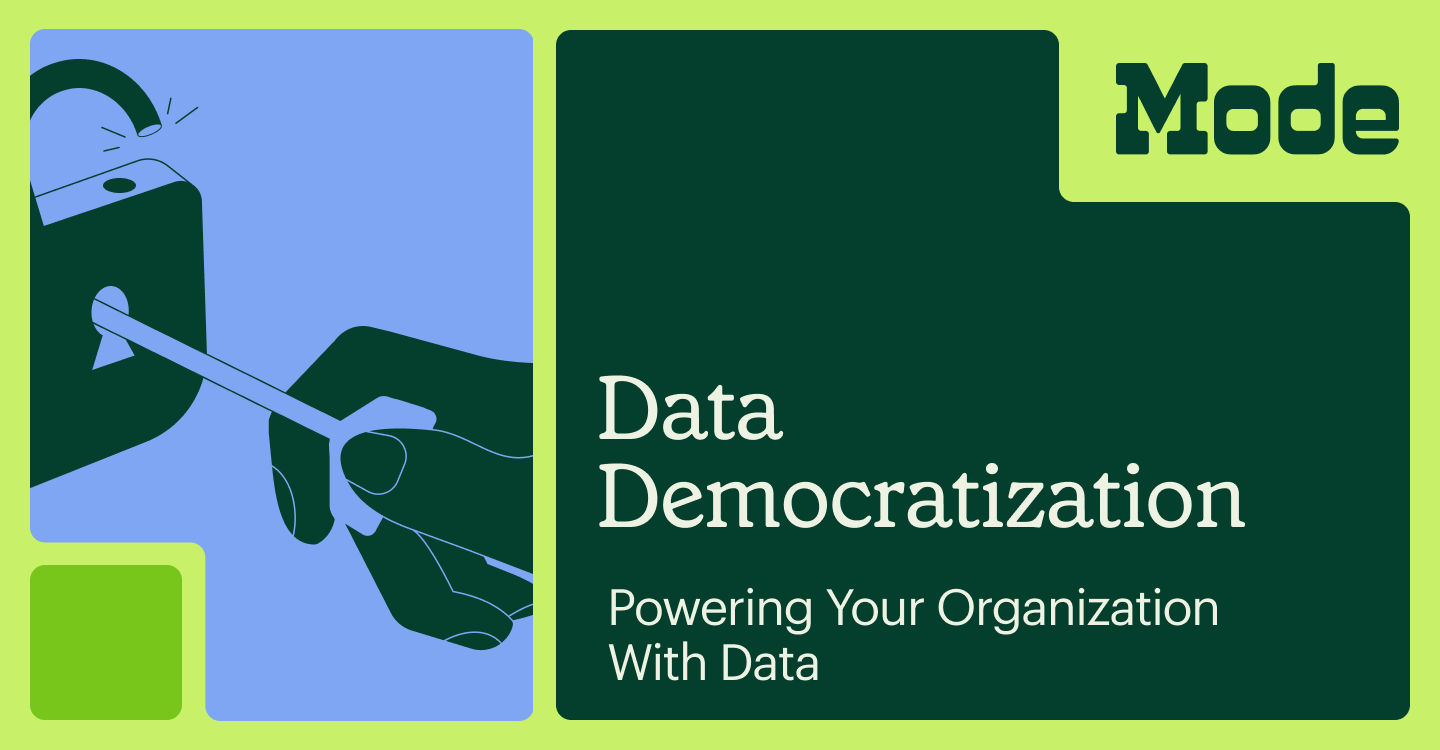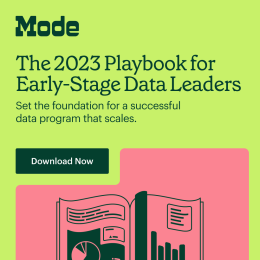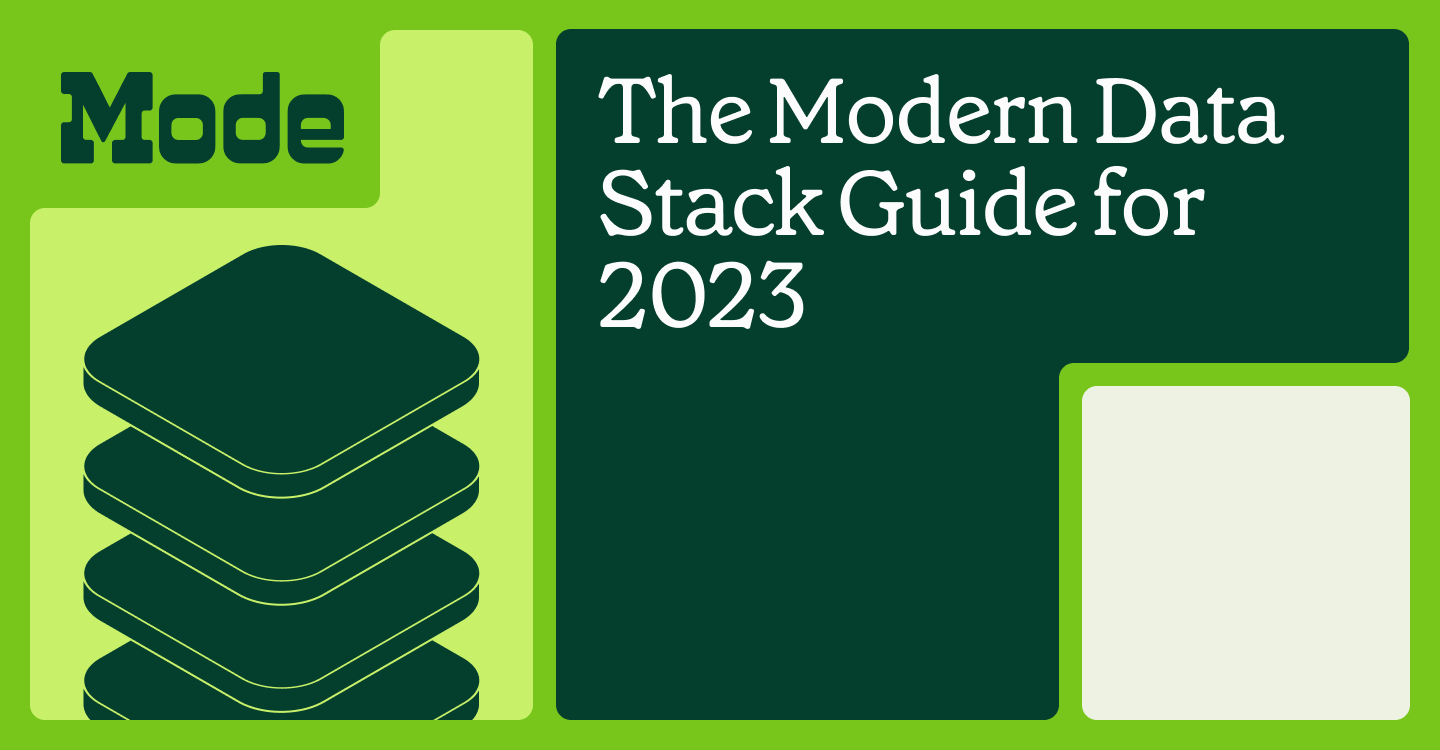Data Democratization: Powering Your Organization With Data
Mark Simborg, Mode writer
June 15, 2023
NaN minute read

If you need to scale the impact of data, you’ve probably thought about data democratization. After all, data silos don’t do an organization any good.
We’re going to cover the basics of what data democratization is, share real-world examples of it, and share how a BI tool should make data democratization easier.
What is data democratization?
Data democratization is the process of making data more accessible to employees within an organization, regardless of their technical expertise.
The purpose of data democratization is to give more people the ability to access and analyze data to make decisions with less effort from the data team.
Data democratization is one spoke of a self-serve analytics strategy, with an emphasis on distributing data throughout an organization.
What is Data Governance? Framework and Examples
The complete guide to a data governance strategy that ensures flexibility and safety.
Why is data democratization important?
We live in an era where data rules the roost. Organizations of all sizes are swimming in a sea of data, and the ability to harness actionable insights from this treasure trove has become crucial for success. That's where data democratization comes into play.
When the relevant data can be accessed by the right teams, organizations can foster a culture of informed decision-making, move faster on initiatives, and drive more innovation.
When Australia’s largest real estate company, Domain, invested in data democratization efforts, it directly contributed to the launch of six new products in a matter of weeks.
Instead of locking up valuable insights within the confines of a select few data experts, democratizing data helps give every individual in your organization the power to access, understand, and leverage data. This relieves your data team of being the 24/7 data experts and enables everyone to get faster answers with data.
What are the benefits of data democratization?
Data democratization breaks down barriers to data and empowers individuals to access and leverage data.
1. Data democratization leads to more data-driven decisions and that means more efficiencies.
When more people have more access to the right data, it lets more people make better data-driven decisions. Data democracy has the opportunity to turn data into a true competitive advantage for the entire organization. Additionally, stakeholders can explore data rather than just look at the data to get what they need.
2. The data team spends more time on more advanced work.
Data democratization means freeing up the data team for more advanced data work rather than having to answer every single ticket in the queue. With good data democratization efforts, analysts can find themselves responding to less duplicate requests and have more time to spend on proactive, strategic projects.
3. Better ROI.
More efficiencies from data-driven decisions across an organization and more time spent on proactive analytics work, means more ROI on your data stack investment.

The 2023 Playbook for Early-Stage Data Leaders
Create a data program that scales.
Why data democratization is a fundamental to creating a data-driven culture
Analysts need their data to be not just understood but used. To actually turn insights from data into actionable strategy, analysts need to create a data-driven culture within the organization. Data democratization fuels a data-driven culture in the following ways:
1. It helps break down data silos
When non-sensitive data is inaccessible, it can lead to information disparities—causing colleagues to spend more time discussing how a lead should be defined, rather than how to generate more of them. Democratizing data helps organizations break down data silos and enables more cross-functional decisions and alignment across departments.
2. It promotes the use of analyst-vetted data
When everyone operates from the same analyst-vetted data, it becomes easier to establish alignment and drive cohesive decision-making with trusted metrics. Learn how Mode makes this easy.
Data teams play a crucial role in ensuring data quality, accuracy, and security. When data teams have a greater role in democratizing data, they can establish processes and frameworks that help business teams validate and prepare data for consumption by a wider audience. This ensures that employees have access to reliable and trustworthy data, minimizing the risk of making decisions based on flawed or incomplete information.
3. It accelerates data-driven decisions
Data democratization empowers employees at all levels to access and analyze data independently, without relying solely on data specialists or analysts. By enabling self-service analytics, organizations can significantly reduce the time and effort required to retrieve insights from data. This acceleration in the decision-making process allows for more agile and responsive actions, leading to increased internal efficiency and a competitive edge in the market.
4. It reduces duplicate work from analysts
Data analysts can easily be burdened with repetitive requests for data retrieval and analysis. This not only makes the data team a bottleneck but also limits the analysts' capacity to focus on more strategic and proactive tasks. Data democratization shifts the responsibility of data exploration and analysis to a broader audience, freeing up analysts' time to concentrate on solving more complex analyses, doing predictive modeling, and providing insights that drive innovation and growth.
Here's what democratizing data can look like
There are many ways data democratization can be done in organizations. Here are some of the most common ones.
1. Giving certain teams permissions to Reports
The first place to start with data democratization is granting permissions to reports that contain relevant and non-sensitive data. Mode makes it easy to use permissions settings for data-sharing within and outside the data team.
2. Sending or scheduling reports via Slack or Email
Another way organizations can democratize their data is by distributing it through the channels people work in. Examples of this would be sending up-to-date reports on an automated schedule on specific Slack channels or emails. These activities ensure data is proactively available to those who need it, reducing dependency on a select few individuals for data dissemination.
3. Making data and reports searchable and well-labeled
Making data easy to discover is an important part of data democratization. Companies can do this with clear labeling and categorization. By employing consistent naming conventions, metadata tagging, and descriptive labels, employees can quickly search and locate the datasets or reports they need. A well-organized and searchable data repository makes data more accessible, letting employees get information quicker and make informed decisions in a timely manner.
4. Embedded analytics
Embedding reports and charts directly into other software platforms like Salesforce, Coda, or WordPress is another effective approach to data democratization. By integrating reports and visualizations into commonly used software or workflows, organizations enable employees to access insights without the need for specialized data analysis skills or separate applications. Embedded analytics ensures that data becomes an integral part of everyday operations, driving efficiency and innovation across departments.
See this article to learn how other companies like TuneIn, Twitch, Zinc, and Thumbtack distribute data, as well as some more examples of how we do it here at Mode.
5. Giving memorable updates at company all-hands
People don't remember data, they remember stories. Company-wide meetings, such as all-hands sessions, present an opportunity to showcase data-driven insights and updates in a memorable and engaging manner. These sessions can include interactive data visualizations, engaging presentations, and storytelling techniques that convey the significance of the data and its implications for the organization.
By presenting data in a compelling and easily digestible format, organizations can ensure that everyone understands the broader context and feels included in the decision-making process. This fosters a culture of transparency, encourages data literacy, and reinforces the importance of data in driving organizational success.
How to put data democratization in play
Effective data democratization means getting trustworthy data to the right people. To effectively implement data democratization at your organization, you will need:
1. Centralize your company's data in a BI tool
To fully realize the powers of data democratization, analysts and business teams should be able to access the data they need from the same platform to reduce tool switching and inconsistencies.
2. Establish some data governance practices (even small ones are good)
Data is only as useful as it is accurate, consistent, and discoverable. Take small actions like standardizing core, business-wide metrics like leads or ARR (use our metrics definition template) while you work toward building longer-term data governance frameworks. Data governance will always be an ongoing process, but small steps and a few processes will go a long way in esnuring data is trustworthy and consistent across all teams.
3. Have data teams distribute data from the center of the company
When data teams can operate at the center of the business, they can own, create, and maintain a central data hub for everyone. This helps business teams work with pre-validated data and lets data teams easily share their guidance upfront. This lets data teams drive from the front office instead of the back. Think: less service desk, more influence.
When data teams can move fast in a BI tool, (which is harder to do in some more than others), it can help them lead data efforts from the center.
4. Power data-savvy stakeholders
Data-savvy folks in your organization can help maintain reports and help make sure that people understand the data they’re looking at. To this end, identify your “data evangelists” — i.e., the people in your org who can help others understand data. Maybe they know SQL, R, Python, or other programming languages. These “data heroes” can help scale data democracy.
Data democratization in a BI tool: What to look for
You’ll want whatever BI tool(s) you use to support your data democratization. Mode meets users where they’re at in technical capability and lets them explore data wherever they are on the spectrum.
Here’s how Mode supports data democratization:
Internal Permissions - Mode helps you secure your data both internally and externally by letting you set permissions and control privacy settings so you can safely share data within your team without jeopardizing sensitive information. Learn more about how we recommend setting up data governance in Mode.
Datasets - Mode’s Datasets lets groups of folks use the same canonical set of data in multiple reports across teams. This reduces repetitive data requests and centralizes key business logic. And as the business evolves, data teams can quickly update the Dataset in one central place and propagate changes out to its users.
Dbt Metrics integration - With Mode’s dbt integration, data teams can bring the critical core metrics that they’ve codified in dbt directly in Mode. This keeps critical metrics trustworthy and consistent.
Report scheduling and sharing - Mode’s report automation lets you schedule query reruns and sends in specific channels, which allows you to shed tedious manual work. You no longer have to worry about sending out the same report, manually rerunning queries to pull the freshest data, and copying and pasting report links for various stakeholders in communication channels. Report automation makes data team workflows easier, data more accessible, and your entire business more data-driven.
Embedded Analytics - Mode’s embedded analytics lets you scale your reporting with branded analytics in lots of applications. You can embed data where your team members are or use White-Label Embeds to share reports across various platforms externally.
Explorations - Mode’s Explorations lets anyone that’s a Mode user view, explore, and build on existing charts and reports. You can create an Exploration to build one-off, personal analysis that doesn’t show up in or change the original report.
Bottom line: Data democratization means better ROI
When business-oriented data teams can influence revenue through all functions of a business in this manner, they become indispensable. With small steps toward data democracy, data teams can influence business strategy with reliable data and ultimately improve their ROI.
Get our weekly data newsletter
Work-related distractions for data enthusiasts.




